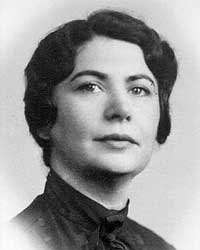Gertrude Blanch
Gertrude Blanch (2 February 1897, in Kolno, Russian Empire (now Poland) – 1 January 1996) was an American mathematician who did pioneering work in numerical analysis and computation. She was a leader of the Mathematical Tables Project in New York from its beginning. She worked later as the assistant director and leader of the Numerical Analysis at UCLA computing division and was head of mathematical research for the Aerospace Research Laboratory at Wright-Patterson Air Force Base in Dayton, Ohio.

Early years and education
Blanch was born Gittel Kaimowitz in Kolno to Wolfe Kaimowitz and Dora Blanc. Kolno was historically a part of Poland, but it was partitioned off in to the Russian Empire at that time. Blanch was the youngest of seven children. Wolfe Kaimowitz emigrated to the United States, and in 1907, Dora Blanc, ten-year-old Blanch, and one other daughter joined him in New York.[1][2]
Blanch attended public schools in New York City. In 1914 she graduated from Eastern District High School in Brooklyn. Later that year, Kaimowitz died, so Blanch decided to take a job to support her family. She worked for fourteen years in clerical positions, saving money for school. She became an American citizen in 1921. After her mother died in 1927, Blanch started taking evening classes at Washington Square College, part of New York University. In 1932, Blanch received her Bachelor of Science degree in Mathematics with a minor in Physics from New York University. That same year, she changed her name from Kaimowitz to Blanch, an Americanized version of her mother's name. She received her Ph.D. from Cornell University in algebraic geometry in 1935.[1]
Career
For a year, she worked as a tutor in place of a colleague on leave at Hunter College; then, she worked as a bookkeeper.[1] In 1938, she began work on the Mathematical Tables Project of the WPA, for which she was "Director of Mathematics" and "Manager of Computation". This entailed designing algorithms that were executed by teams of human computers under her direction. Many of these computers possessed only rudimentary mathematical skills, but the algorithms and error checking in the Mathematical Tables Project were sufficiently well designed that their output defined the standard for transcendental function solution for decades. This project later became the Computation Laboratory of the National Bureau of Standards.
The Mathematical Tables Project became an independent organization following the termination of the WPA at the end of 1942. During World War II, it operated as a major computing office for the US government and did calculations for the Office for Scientific Research and Development, the Army, the Navy, the Manhattan Project and other institutions. Blanch led the group throughout the war.
After the war, Blanch's career was hampered by FBI suspicions that she was secretly a communist. Their evidence for this seems scarce and included, for example, the observation that she had never married or had children, as well as the fact that her sister was affiliated with the Communist Party.[1] In what must have been a remarkable showdown, the diminutive 50-year-old mathematician demanded, and won, a hearing to clear her name.
Subsequently, she worked for the Institute for Numerical Analysis at UCLA and the Aerospace Research Laboratory at Wright-Patterson Air Force Base in Dayton, Ohio. She was an early member of the ACM.
Publications
She published over 30 articles on functional approximation, numerical analysis and Mathieu functions. In 1962, she was elected a Fellow in the American Association for the Advancement of Science. In 1964, she received the Federal Woman's Award, an award for women who had exemplary professional service in the United States Government.
- The Gertrude Blanch Papers (1932–1996)[3]
Honors and awards
Later years
Blanch retired in 1967 at the age of 69, but continued working under a consulting contract for the Air Force for another year. Thereafter she moved to San Diego and continued to work on numerical solutions of Mathieu functions until her death in 1996, concentrating on the use of continued fractions to achieve highly accurate results in a small number of computational steps. This work has not been published.
The Gertrude Blanch Papers, 1932–1996 are accessible at the Charles Babbage Institute, University of Minnesota, Minneapolis.
References
- "Blanch biography". www-history.mcs.st-and.ac.uk. Retrieved 2017-02-01.
- Green, Judy; LaDuke, Jeanne (January 2009). "Blanch, Gertrude". Pioneering Women in American Mathematics: The Pre-1940 PhD's. American Mathematical Society. pp. 144–145. ISBN 978-0-8218-4376-5. Biography on p. 83–89 of the Supplementary Material at AMS.
- "Gertrude Blanch". Retrieved 2017-02-01.
- NIST
- Grier, David Alan, "Gertrude Blanch of the Mathematical Tables Project", Annals of the History of Computing, 19.4 (1997), 18–27.
- Grier, David Alan, "The Math Tables Project of the Work Projects Administration: the reluctant start of the computing era", Annals of the History of Computing, 20 (1998), 33–50.
- Grier, David Alan, "When Computers Were Human", 2005.
External links
- "Gertrude Blanch", Biographies of Women Mathematicians, Agnes Scott College
- Gertrude Blanch Papers, 1932-1996 Charles Babbage Institute, University of Minnesota, Minneapolis.
- Computer Oral History Collection: Dr. Gertrude Blanch, 1969-1973 Smithsonian National Museum of American History
- Gertrude Blanch, The History of Numerical Analysis and Scientific Computing
- Blanch Biography, University of St Andrews